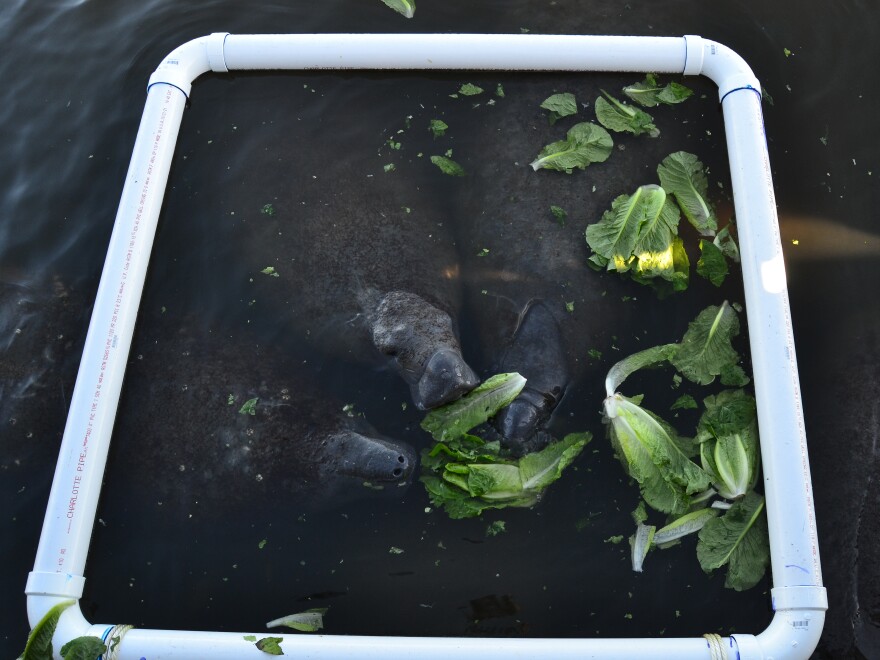Updated March 21, 2022 at 6:56 PM ET
Not long ago, seagrass spanned the 156-mile Indian River Lagoon like a vast underwater meadow, nourished by sunlight that reached through the crystalline water. The lagoon, an estuary on Florida's east coast, is among the most biodiverse on the continent, and has been a crucial habitat for manatees. But today its underwater meadow is gone.
Decades of nutrient pollution flowing from fast-growing communities and farm lands along the lagoon's shores have left the water cloudy with harmful algal blooms, which can prevent sunlight from reaching the seagrass below. In parts of the lagoon as much as 96 percent of the seagrass has been lost, leading to a record die-off of some 1,100 manatees in Florida last year.
But a quick boat trip from the city of Satellite Beach, in one spot where the lagoon water laps at the thick mangroves of a tiny island, a small but vital effort is underway to regrow the seagrass.
From an idling pontoon, Nicholas Frank Sanzone, the city's environmental programs coordinator, says some 13,500 seagrass plugs were planted last year within this one-acre site, along with oysters and clams to serve as natural water filters. The effort was successful, until an animal – perhaps a manatee, he says – swept in and ate all the seagrass.
"If we can get seagrass to grow here," Sanzone says, "the odds are that we can get it to grow in similar locations throughout the lagoon."
Cleaning up the polluted lagoon could take decades and cost billions
Florida's staggering manatee die-off now is projected to last for years, and wildlife agencies are bracing for the worst by expanding their rescue and rehabilitation program. They have resorted to providing supplemental lettuce for starving manatees. Already this year some 420 are dead in Florida, a number that tracks closely with this time last year.

But the wildlife agencies say they have no way of measuring how effective the lettuce has been at preventing more deaths and acknowledge the manatees need a lot more than lettuce. Saving the federally protected manatees, they say, means saving this habitat, a monumental effort.
The Indian River Lagoon National Estuary Program, administered by the Environmental Protection Agency, estimates a comprehensive restoration of the lagoon would cost $5 billion and take some 20 to 30 years to complete.
"Nobody has done this scale of restoration, from a system this impacted," says Virginia Barker, director of Brevard County's Natural Resources Management Department.
Some 70 percent of the Indian River Lagoon is situated in Brevard County, home to the Kennedy Space Center. Of the six counties where the lagoon flows Brevard has offered up the most money for restoration at $542 million, funded by a half-cent sales tax voters approved after a widespread fish kill in 2016.
The restoration involves wastewater treatment plant upgrades, septic-to-sewer conversions, hundreds of stormwater treatment projects and dredging from the lagoon's bottom vast amounts of muck representing decades of accumulated debris associated with fish and seagrass die-offs.
Barker says the effort is showing promise, but it was developed at a time when seagrass still was present in large swaths of the lagoon.
"The amount of nutrient reduction that is needed to flip that system back to a seagrass-dominated, oligotrophic system may be much more than what the prior modeling had indicated," she says. An oligotrophic system is one that is more pristine with little to no nutrient pollution.
"We have a dust bowl underwater," Barker says. "So how do you restore tens of thousands of acres of seagrass to an underwater dust bowl, where there's nothing to hold those sediments still?"
There are also fears that the harmful algal blooms could get worse as water temperatures warm with climate change.
Many more species than manatee are being harmed
The Florida Legislature has budgeted millions of dollars for manatee habitat restoration. The funding will go toward a series of projects, several of them involving re-growing seagrass in the Indian River Lagoon, including at Satellite Beach. The lagoon also gets funding from federal and state agencies including the EPA, Florida Department of Environmental Protection, St. Johns River Water Management District and South Florida Water Management District.
The infrastructure measure President Biden signed into law in November includes money for an Everglades restoration project aimed at improving flows into the southern part of the lagoon.

But the costs associated with wastewater treatment plant upgrades and septic-to-sewer conversions are enormous, and without dedicated funding for that, real change will be difficult, Barker says. Even simply creating such a long-term plan for restoration is a challenge.
"Why would you take the limited dollars that you have to do that design and permitting if you have no idea whether you're going to be able to come up with the construction funds three to five years down the road, when you're ready for that stage of the process," she says.
The Save the Manatee Club, Center for Biological Diversity and Defenders of Wildlife have sued the U.S. Fish and Wildlife Service in federal court over the manatees' habitat. The groups want the federal agency to update and strengthen habitat protections under the Endangered Species Act that they say have not been revised since 1976. They've also filed a notice of intent to sue the EPA over water pollution, primarily in the Indian River Lagoon.
Pat Rose is executive director of the Save the Manatee Club and an aquatic biologist who has spent 40 years trying to help the marine mammals. He says the Indian River Lagoon's needs are urgent because the widespread loss of seagrass also affects many other species, including sea turtles and even dolphins, who have fewer fish to eat.
"This is a situation we thought never would happen," he says, "and it certainly never should have happened."
This story is a collaboration between Inside Climate News and WMFE Orlando, a member of ICN's National Reporting Network-Southeast.
Copyright 2022 WMFE


